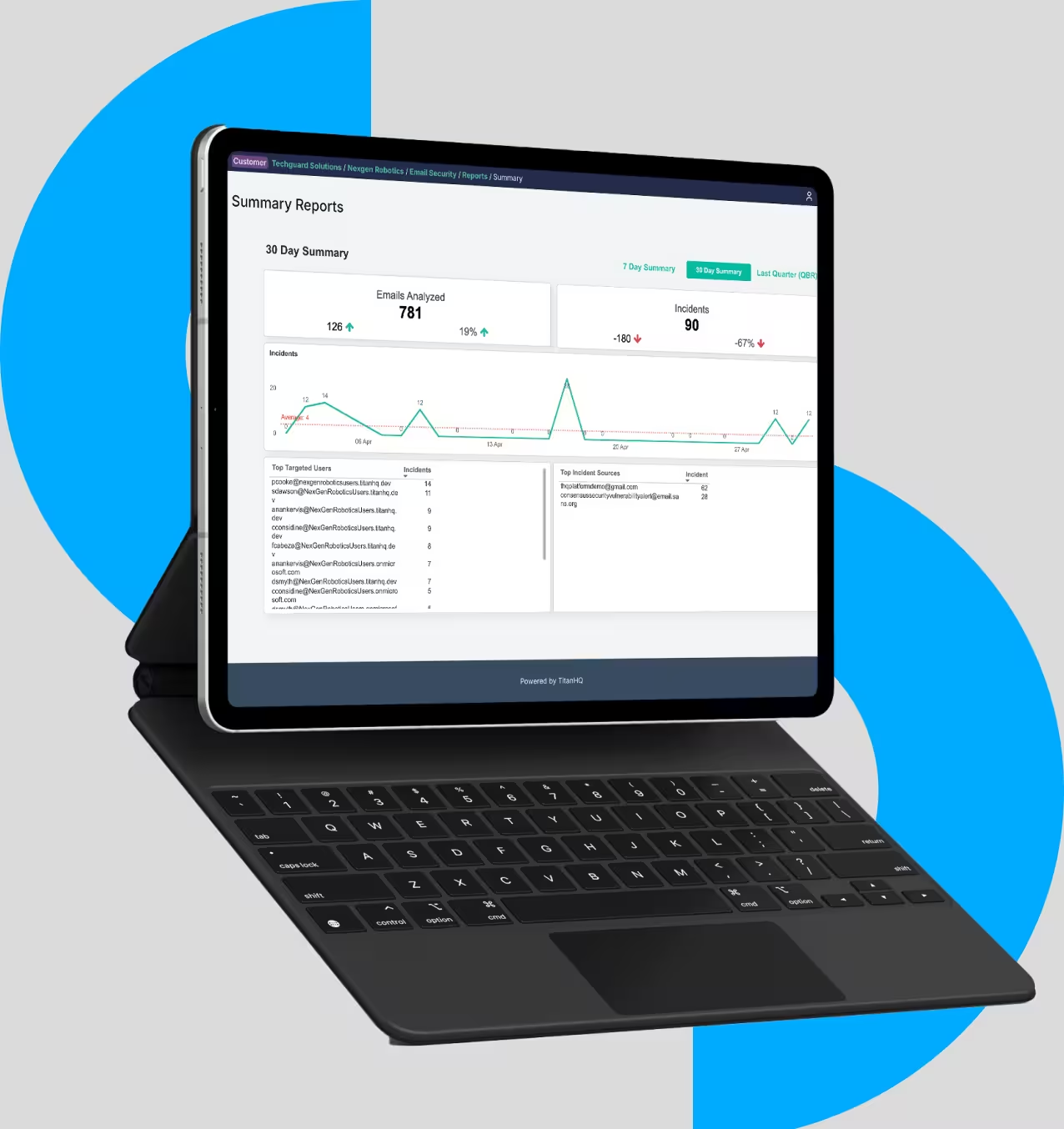What is simulated phishing?
Phishing attacks are proliferating, becoming faster, more personalized, and harder to detect as cybercriminals increasingly leverage AI.
- AI is predicted to be involved in 17% of cyberattacks by 2027.
- The 2024 IBM ‘Cost of a Breach’ report estimated $4.88M per phishing breach (IBM Cost of a Data Breach Report 2024).
As phishing attacks reach new heights, the good news is that it’s possible to reduce phishing risk measurably with phishing simulation training.
CyberSentriq’s Employee Phishing Training provides employees with a safe way to practice identifying and mitigating these threats before they escalate into real problems. Through realistic, hands-on exercises, your staff builds confidence and knows how to react quickly when something looks suspicious. The payoff? A workforce that’s not just aware of phishing but ready to shut it down before it causes damage.
Phishing emails can have dire consequences for an organization. These malicious emails are used to steal login credentials, initiate malware infections, and carry out Business Email Compromise (BEC) scams.
- According to research from Osterman, nearly two-thirds (64%) of businesses anticipate an increase in phishing attacks.
- One-fifth of companies have lost money due to a BEC scam.
AI automates phishing campaigns. Services like WormGPT and FraudGPT offer Phishing-as-a-Service, enabling anyone intent on committing scams and fraud to access email phishing capabilities. Evasive tactics used by cybercriminals to circumvent email security solutions, such as Microsoft EOP and Defender, enable malicious phishing emails to enter inboxes, deceive employees, and initiate full-blown cyberattacks. This is where simulated phishing platforms can help to mitigate the impact of phishing.
Simulated phishing is a programmatic method used to educate employees on the techniques and tactics employed in phishing attacks. AI-powered simulated phishing platforms are used to send simulated phishing emails to staff and other individuals, such as contractors and vendors. These pseudo-phishing emails serve as the foundation of a phishing education program designed to empower employees and others with the knowledge to recognize and prevent phishing attacks.
How do phishing simulation platforms work?
A phishing simulation platform is a cloud-based service that generates and delivers pseudo-phishing emails. The platform typically provides templates that serve as a basis for creating fake phishing emails. The templates must be highly configurable to reflect changes in phishing emails as new tactics emerge in the landscape. For example, a spoof phishing email may incorporate a QR code to reflect the use of these codes in real phishing campaigns.
Simulated phishing platforms must be configurable to reflect cyber threats targeting specific roles and individuals. For example, BEC scams target C-level management and accounts payable staff. In this case, the simulated phishing platform would enable the administrator to create a BEC scam campaign, which would then be sent to individuals in those roles.
Once configured, the simulated phishing platform will be set to automate the delivery of the test emails to all or a subset of the workforce, down to the individual level. When a recipient receives the spoof email, the system will record how that person interacts with the test. The goal is to educate the user and encourage them to submit an incident report. For example, if the recipient clicks on a malicious link, they will receive an immediate, interactive session that explains the “What would happen next scenario…” Over time, this interactive feedback helps build an individual's knowledge base. Having a deep understanding of the techniques and tactics used in human-centered cyberattacks empowers employees to identify and prevent cyberattacks that target them as individuals or the roles they play within an organization.
Employee phishing simulation training doesn’t just test your team; it gives you the data you need to make them stronger. With built-in reporting, administrators can see exactly how each campaign performs and spot employees who might be more vulnerable to phishing attempts. Instead of treating everyone the same, these insights let you tailor future simulations, giving individuals the practice they need to build better habits and sharpen their defenses over time.
Automation of phishing simulation platforms minimizes the administrative overhead required to run campaigns.
What are the benefits of phishing simulation platforms?
Using a simulated phishing exercise has many benefits for individuals and companies.
- Simulated phishing campaigns reflect real-world threats.
- Role-based fake phishing campaigns train employees at high risk of threats such as Business Email Compromise (BEC) and ransomware attacks.
- Automation facilitates the regular training of employees.
- Provides contextual feedback to employees as part of the training so that they develop a deeper understanding of the impact of phishing.
- Generates real-time metrics to allow further tailoring of simulated phishing sessions to improve the effectiveness of the training.
- Integrates with other security awareness training so that employees have a comprehensive understanding of how to handle phishing attacks.

What are the key features of a phishing simulation platform?
Automated
Must use a “set-and-forget-it” automation setting to allow an IT department or an MSP to configure the fake phishing campaigns and leave the system to deliver, educate, record, and report. An MSP or organization must be able to rapidly add new customers and users to live campaigns.
Personalized
Templates should provide the basis for highly customized campaigns. This feature is essential, as cyber threats continually evolve to incorporate sophisticated messaging and employ evasive tactics. Platforms must provide mechanisms for targeting specific roles and individuals in an organization to reflect targeted threat levels.
Configurable
The platform must be highly configurable to accurately reflect the specific needs of an organization, its sector, and its employees. The platform can benefit from deep integration with existing environments, for example, allowing users to be searched and selected for, based on their M365 job title or their M365 manager.
Multi-lure simulated phishing
This optional feature provides randomized lures during a phishing campaign. Lures can be delivered using a stealth mode to maintain an element of surprise, mimicking a realistic phishing campaign.
Real-Time Intervention Training
Interactive and real-time interventions are essential educational tools to ensure that trainees understand what would happen next if the phishing email were real.
Simplified incident reporting
Roles and individuals receiving training should be able to click to report an incident as it happens. Fake phishing emails are a valuable way to train users to report incidents quickly, allowing for a fast response to a threat.
Comprehensive dashboards
At-a-glance dashboards should provide immediate insights into the progress of a fake phishing campaign. An MSP should be able to quickly see which customers are enrolled in phishing campaigns and which are not.
Proof of success
A simulated phishing platform should provide evidence of its success in use. Success rates of 90% or higher reductions in phishing susceptibility are achievable.
MSP delivered phishing simulations for client employees
Managed service providers (MSPs) can enhance client security by incorporating simulated phishing into a comprehensive security awareness training program. Phishing simulations should be offered in conjunction with Integrated Cloud Email Security (ICES) and secure backups to deliver unified and comprehensive cybersecurity to your clients. To provide adequate, scalable protection, MSP offerings should go beyond the core features of a single layer of security to include three key pillars:
Multi-tenant management
A centralized, cloud-based console that lets MSPs manage all customers in one place, reducing administrative overhead.
Automated protection
Fast, automated onboarding to quickly add new accounts without manual complexity.
Cross-sell readiness
Seamless bundling with Microsoft 365, Azure Blob, and Entra ID to increase value and margins.

By leveraging simulated phishing exercises, organizations can proactively train employees and the broader user base to recognize and respond to these threats before they escalate into costly security incidents. This hands-on, practical approach not only strengthens individual awareness but also builds a culture of vigilance across the organization. Investing in phishing simulation training today means reducing risk, protecting sensitive data, and staying one step ahead of cybercriminals tomorrow.
Phishing simulation is a quick, seamless, and cost-effective way to strengthen all of your customers' security defenses against phishing attacks through continuous phishing simulation campaigns!
Ready to get started?

